Thursday night was the final gaming night
before Christmas, and I ran
The Thing in the Chimney for a table
of six, two of whom were new gamers, and for whom
TTITC was their
“zero-level funnel”. The other
characters were the newly-levelled survivors from Fallen Tempesta in my home
game….an online version of this adventure is being played out
here.
The game started with the characters in the
Great Hall, and then almost immediately split up. Some went to the wood growing at one of the
hall, some took the passage to the kitchen, and some stayed in the Great Hall
to look around.
There was actually a surprising amount of
party-splitting in this adventure, and it had interesting repercussions to game
play. I was surprised and pleased to
note that the players immediately began to make a map, and they were not at all
confused by the way the Cinder Claws’ home worked….they caught on mighty quick. I suppose I should not have been surprised,
though, as they have been steadily developing in the mapping department.
The characters decided not to disturb the
cooks in the kitchen. One of them stole
a couple of cookies, to see if there would be a reaction, but there was
none. They then proceeded through both
alternate doors, splitting the party up further.
One group investigated the reindeer
stables, but passed on quickly. A shovel
was taken here, that was later put to good use.
Meanwhile, another part of the group
discovered the tinsel on the trees, and became aware of the large
double-doors. Throwing caution to the
wind, the entered the wood, and met with the tinsel spiders. One of the other groups came out of the
reindeer area and was able to render aid…they fought 3 out of 5 spiders without
any real incident. They fought the other
two when they tried to push the door open….and one of the characters, a
halfling, got silver glop stuck on his left hand.
They pushed the door open, discovered the
wasteland outside, and realized that they could not close it. Ah, well, spiders don’t like cold.
Needless to say, players began having
characters in the scrying chamber check the list to see if they were Naughty or
Nice. This led to one of the PCs (a
thief whose occupation was “counterfeiter”) trying to change what the list
said, to no avail. They also,
predictably, made attempts to steal the list, and the snow globe. They were so focused on these items, though,
that they ignored or forgot about the rubies on the snow globe stand.
They found the sleigh, and one character
took the cindercrop. Exploration
of the enormous red velvet bag was not very thorough, and it was left
behind. The players originally thought
that the double doors in the sleigh room and the Great Hall must connect. Now they are not so sure, because of the
events in the Great Hall, and they are considering not opening them.
Dealing with the fruitcake was relatively
easy for them, as one of the PCs had previously gained the ability to create
strong pheromones once per day, which were used to counteract the fruitcake’s
lure. Throwing the ancient, evil desert
into the fireplace, they discovered the empty stockings for the first time.
They also discovered that tinsel spider
glop cannot be removed by clerical healing.
Most of the characters return to the Great
Hall, where they decide to split up and explore the remaining two archways –
half the party heads to the sweatshop, while the other half heads to the guard
room. At the guard room, four elf spears
are cast into the front line, and the first character is slain.
At this point, all hell finally breaks
loose. The PCs headed towards the guard
room flee, with six elf guards behind them.
The PCs in the sweatshop pass through the green door, and arrive in the
guard room behind the other six guards.
Two snowmen are back in the hall where the door has been left open. In the general melee that follows, one
character is killed when a snowman throws a snowball at him, gets a critical
hit, shatters the character’s forearm, and does enough damage to down him. When the other PCs turn over the body, it is
too late.
I rule that, due to the distraction of the
other characters, the PCs coming through the green door get surprise. Between two locations, elves, and snowmen, a
great deal of fun is to be had. Someone
shouted “knock off their hats!” right away, but no one heeded this advice. The PCs are battered and bruised, but
ultimately victorious.
(As a side note: The PC whose forearm was broken, and who
subsequently died, was a cleric who pushed his luck, had to roll 5d4 for
disapproval, and then was found (thus far) to be pretty much a man of the
world. This was the “worst” disapproval
rolled at my table yet, or the “best”, depending upon your point of view, but
it really reinforced my enjoyment of the system.)
Of course, being players, they had to open
the other double doors (giving the sleigh access to outside), and fought the
snowman with the ukulele. I played Burl
Ives singing Silver and Gold and Perry Como singing Winter Wonderland to simulate
the snowman’s singing. “Wait a minute….is
the snowman really singing that?!?” “Yes.”
At this point, the night was getting late,
and I was ready to fill their stockings.
However, because they kept splitting the party, and there were always
folks in the Great Hall, there was no chance for the Cinder Claws to come
immediately. One of the players tried to
put the fire out with the snow, but the fire was too great for what she could
do with the shovel. So, she decided to
take coals from the fire and burn the wood down instead. With the resultant smoke and heat, the group
scattered out of the Great Hall, and I was able to stage the final encounter.
(That was a pleasantly unexpected action
for a player to think of.)
The hands were very effective. The long, flexible arms were great. That the Cinder Claws was strong they already
knew from the doors; that he was stronger than eight people trying to keep his
arm from going back up the chimney was a new, and perhaps frightening,
revelation.
When the Cinder Claws actually appeared,
though, Fate takes a hand, and the dice roll very hot for the players. There are a number of critical hits as the
Claws pulls itself from the chimney, resulting in its being severely damaged by
the beginning of the first round. It
lets out a Ho Ho Ho! and two icicles fall.
The players like that it has a chance of being hit by this. One PC is hit and killed by falling ice. And then the PCs remaining lay into the
Cinder Claws, and he retreats back up the chimney in a bloody mess.
But that first round has a terrible cost
for one PC. Using my “Slippery Slope of
Arcane Doom” house rule, one character tries to learn magic shield on the fly. He
succeeds, but his Mercurial Magic is unfortunate – each time the spell is cast,
someone he knows dies. The Tempesta
start includes everyone (apart from the party) in the PCs’ homeland being slain….and
the PCs are now on another plane of existence from where they began in any
event. The magic, I rule, utilizes the
life force of someone you know to grant the bonus – and one of the PCs dies.
That’s about it. They grab their stockings, and flee through
the portal. Luckily, they remember to
take their moon rover with them.
But that’s another story.
I am thinking of doing another one for next year: Revenge of the Cinder Claws. What do you think?
(BTW, if you like bygrinstow's illustration of a sugar plum faerie, above, please drop by his blog and tell him so!)







